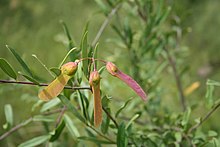Polygalaceae
| Polygalaceae | |
|---|---|

| |
| Securidaca longipedunculata | |
| Scientific classification | |
| Kingdom: | Plantae |
| Clade: | Tracheophytes |
| Clade: | Angiosperms |
| Clade: | Eudicots |
| Clade: | Rosids |
| Order: | Fabales |
| Family: | Polygalaceae Hoffmanns. & Link[1] |
| Type genus | |
| Polygala | |
| Tribes | |

| |
| Distribution of the Polygalaceae | |
| Synonyms | |
| |
The Polygalaceae or the milkwort
milkworts
.
The family was first described in 1809 by
Robert Chodat split it into 3 tribes. A fourth tribe was split off from the tribe Polygaleae in 1992.[4] Under the Cronquist classification system, Polygalaceae were treated in a separate order of their own, Polygalales. Currently, according to the Angiosperm Phylogeny Group
, the family belongs in Fabales.
Description
Polygalaceae are
verticillate.[6] Each flower usually contains 8 stamens, though this may range from 3 to 10. They are usually in 2 series.[7] The fruits of each plant can be a capsule, samara, or drupe.[6]
Tribes and genera
The Polygalaceae comprise the following genera,[6] with tribes based on various sources.[8][9][10][11][12][13]
- Carpolobieae Eriksen
- Atroxima Stapf
- Carpolobia G. Don
- Moutabeae Chodat
- Barnhartia Gleason
- Diclidanthera Mart.
- Eriandra P. Royen & Steenis
- Moutabea Aubl.
- Polygaleae Chodat
- Acanthocladus Klotzsch ex Hassk.
- Ancylotropis B.Eriksen
- Asemeia Raf.
- Badiera DC.
- Bredemeyera Willd.
- Caamembeca J.F.B. Pastore
- Comesperma Labill.
- Epirixanthes Blume
- Gymnospora (Chodat) J.F.B.Pastore
- Hebecarpa (Chodat) J.R.Abbott
- Heterosamara Kuntze
- Hualania Phil.
- Monnina Ruiz & Pav.
- Monrosia Grondona
- Muraltia DC.
- Phlebotaenia Griseb.
- Polygala L.
- Polygaloides Haller
- Rhamphopetalum J.F.B.Pastore & M.Mota
- Rhinotropis (S.F. Blake) J.R. Abbott
- Salomonia Lour.
- Securidaca L.
- Xanthophylleae Chodat
- Xanthophyllum Roxb.
Fossils
- †Deviacer Manchester
- †Paleosecuridaca Pigg, Kathleen B., M.L. DeVore & M.F. Wojc. 2008
Systematics
Modern molecular phylogenetics suggest the following relationships:[13][14][15][16][17][18]
| ||||||||||||||||||||||||||||||||||||||||||||||||||||||||||||||||||||||||||||||||||||||||
References
- hdl:10654/18083. Retrieved 2013-07-06.
- .
- ^ Harvard University; Royal Botanic Gardens Kew; Australian National Herbarium. "Polygalaceae". International Plant Names Index. Retrieved July 16, 2020.
- S2CID 32590790.
- ^ Messina, Andre (2022). Kodela, P.G. (ed.). "Polygalaceae Hoffmanns. & Link". Flora of Australia. Australian Biological Resources Study, Department of Climate Change, Energy, the Environment and Water: Canberra. Retrieved 15 April 2024.
- ^ a b c d "Polygalaceae Hoffmanns. & Link". Plants of the World Online. Royal Botanic Gardens, Kew. Retrieved 17 April 2024.
- ^ a b "Polygalaceae". Flora of Victoria. Government of Victoria, Australia. Retrieved July 16, 2020.
- JSTOR 41972495.
- S2CID 19252598.
- S2CID 85269764.
- S2CID 22601207.
- ^ Freire-Fierro A. (2015). Systematics of Monnina (Polygalaceae) (Ph.D.). Drexel University. Archived from the original on 2017-03-19. Retrieved 2017-03-19.
- ^ S2CID 90353852.
- JSTOR 1223706.
- S2CID 37523521.
- S2CID 85655712.
- ^ Abbott JR. (2009). Phylogeny of the Polygalaceae and a revision of Badiera (PDF) (Ph.D.). University of Florida.
- PMID 25878092.
